[one_half padding=”0 0 0 0px”][one_half]
Daniel Defense DDM4v5
By Tom McHale[/one_half]
[one_half_last]
![]() [/one_half_last]
[/one_half_last]

The Daniel Defense DDM4v5 300 Blackout with some upgrades: Ergo grip, SilencerCo Octane 45 suppressor, LaserMax UNI-MAX ES, and Weaver KASPA optic.
You might say Daniel Defense rifles are built from the parts up. The company started by making a simple part—a receiver-mounted sling loop. You know, it’s that typical American success story. Some person out there has a better idea, figures out how to make it, then sells it to the masses. In an oversimplified sense, that’s sort of how Daniel Defense rifles came to be.
After the sling loop had started to sell, Marty Daniel figured he could also invent a better rail system for AR-type rifles. Ultimately, he figured, why not build a whole rifle from the ground up using parts designed and manufactured mostly in-house?
When it comes to rifles, ground up really refers to barrel out. One of the first big equipment investments at Daniel Defense was a cold hammer forging machine for making barrels in-house. Cold hammer forging is kind of a cool process. You take a steel tube with a hole in it, insert a perfect 3D mirror image of the barrel interior and chamber (a mandrel), then pound the living crap out of the outside of the tube until the interior takes the form of the mandrel inside.
The reason for all this pounding and noise is that the end result is a smoother and stronger finished product, and that leads to better accuracy and longer barrel life. No pain, no gain, right?
The hammer forged barrel on this rifle shoots 300 Blackout. Let’s take a momentary detour….
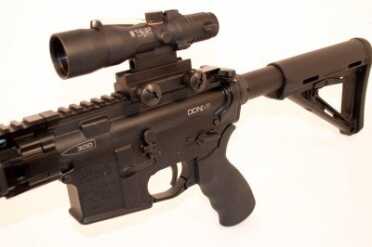
The DDM4v5-300 is shown here with a Trijicon 3×30 ACOG with a special 300 Blackout reticle. It has hold points for supersonic and subsonic rounds.
Some phrases are just fightin’ words.
“That’s MY horse!”
“That’s MY daughter!”
“I love the 300 Blackout!”
For some reason, virtually any gunny discussion about the 300 AAC Blackout cartridge quickly devolves into a typing wind sprint where the winner itemizes more reasons why the 300 Blackout is not as good as (fill in your favorite cartridge here.)
Due to the unique performance characteristics and its wide range of velocity and projectile weight combinations, it gets poked in the eye from both ends of the ballistic spectrum.
The high speed supersonic crowd gets bent out of shape because, in their words, the 300 Blackout…
“Doesn’t have the same energy or reliability as the 7.62×39 AK-47 round.”
“Doesn’t have the ‘reach out and touch someone’ range of the 6.8 SPC.”
“Ammo is way more expensive than the .223 Remington / 5.56mm!”
The rumble and bumble subsonic cartridge fans claim…
“Why not use a pistol or MP-5?”
“Subsonic is unreliable unless you use a silencer.”
“Ammo is way more expensive than 5.56mm!”
This reaction is understandable. We all know that if you encounter someone who’s wrong on the internet, you have to rectify the situation immediately, right?
As with most debates, there are a lot of elements of truth in all of these statements. But I don’t really care. That’s because, for me, whether the 300 Blackout is interesting or not isn’t a binary question. It doesn’t have to be better than (fill in the blank.) I like the fact that it’s a different option with unique capabilities. In fairness, I might be more biased in favor because I’m a reloading enthusiast, and the 300 Blackout is a reloaders dream.
What’s 300 AAC Blackout?
The simple explanation is that the cartridge offers 30-caliber performance and viable subsonic options from a standard 5.56mm AR platform. A 30-caliber barrel swap is required, but other than that, the bolt, carrier, receivers and magazines are compatible.
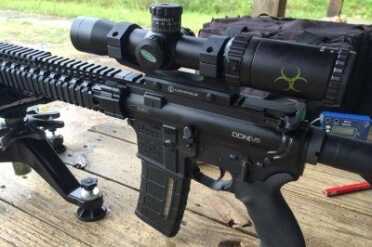
We’ll be looking at scopes in detail in a future article, but one fun option was this Weaver KASPA with CIRT reticle.
Without delving into the debate here, the idea is to provide improved terminal performance, especially from short-barreled rifle platforms. The subsonic option is interesting, as a 300 Blackout can launch a 208 to 245 grain projectile in the 1,000 feet per second velocity range. When used with a suppressor, the sound level is very, very quiet. Switching a 300 Blackout rifle from supersonic to subsonic performance involves no more than a magazine change. We’ll get into more detail on the wide variety of cartridge options later in this article series.
One big drawback to shooting 300 Blackout is ammo cost and availability. That pesky supply/demand thing means that since there is much less manufactured, it’s expensive and harder to find. If you shoot 300 Blackout, it’s in your best interest to reload your own ammunition.
Let’s get back to the rifle at hand.
The DDM4 series is infinitely configurable, so I’ll talk about the options I chose for this rifle here. Just be aware that you can build your own at the Daniel Defense website if you want to tweak options like trigger, chrome, iron sights, rail type, flash suppressor and more.
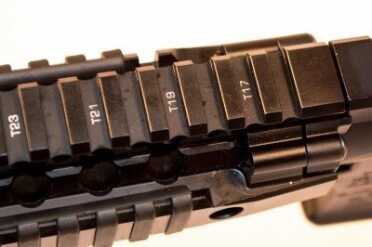
All four rails are clearly marked so you can document preferred mount points for accessories that may come on and off over time.
Let’s touch on some of the high points of this rifle, then we’ll talk about significant details. It’s well built for military-level reliability. Gas keys are staked, parts are mil-spec compatible, and Daniel Defense pays attention to the little things that add up to long-term performance under rough conditions.
You’ll also find some extras that contribute to military-style performance. The rifle includes a Magpul MOE six-position butt stock. The Magpul stock has multiple sling loops and a padded butt plate cover for better traction and recoil reduction, not that 300 Blackout recoil is heavy. You’ll also find a Magpul MOE trigger guard, which bows outward to provide a little room for gloved hands.
The rifle includes a low-profile gas block that allows the 12-inch rail to completely cover it and offer rail space well forward. As a result, when you order a DDM4v5 you decide whether you want iron sights or not. If you do, they are not part of the gas block and sit on the forward rail. The default muzzle device is a Daniel Defense 1.875-inch flash suppressor, but you can choose from a variety of flash suppressors and muzzle climb mitigators.
Rails
Hang with me for a second, as this gets tricky. The Daniel Defense DDM4v5 comes with the… DDM4 rail. Keeps things simple, doesn’t it? It’s designed specifically for Daniel Defense rifles, and the core design is carried over from Daniel Defense’s military rail system, the Rail Integrated System (RIS) II. The rail is completely free floated, so feel free to add slings or bipods—you won’t interfere with shooting performance.
What you need to know is this. Depending on what rifle you order, the rails are available in different lengths. On the test rifle, a DDM4v5 300 AAC Blackout, it’s a 12-inch rail. It’s got numbered attachment points on all four sides and four Quick Attach/Detach holes for slings and whatever other Quick Detach (QD) things you’ve got. Two QD points are on each side, front and back. The numbers are printed on every other slot on all four rails. This is important if you have accessories, like grenade launchers, that you want to mount in the same position as last time. As you might guess, the rail matches up perfectly with the receiver rail segment, so if you use things like iron sights, they’ll be on the exact same plane.
The Daniel Defense rifle comes preconfigured with a vertical fore grip. These are cool, and I generally like them on a home defense or short-range gun. However, I do find they get in the way for longer-range shooting when you might want to rest your rifle on a shooting bag or other support. So I took it off.
While we’re talking about the rails, I did choose to add a LaserMax UNI-MAX ES to the bottom rail. I like this unit for a mixed-use rifle. It’s an extremely low-profile laser unit with a remote activation pad. On a rifle with four rails like this Daniel Defense model, you can configure it just about any way you want, and it will be out of the way for normal daylight shooting.
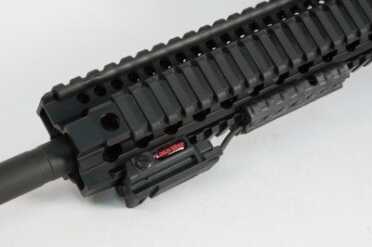
The LaserMax UNI-MAX mounted on the bottom rail is low profile and does not interfere with shooting from a rest.
I mounted the laser unit itself on the bottom rail, as close as possible to the muzzle. I mounted the remote activation pad on the right side, which for me, is the far-side rail for the support hand. Using a normal support hand grip up front, I can choose to squeeze the laser activation pad or not. Mounted on the bottom, the laser is centered with the bore laterally, and I only have to account for the laser beam emitting one inch below the bore vertically. It’s a nice setup for this rifle, especially if you’re into night or twilight hog eradication activities.
Trigger
The model tested included a standard mil-spec trigger. It has a slightly gritty short take-up, followed by a reasonably crisp break. I felt just a bit of over travel. Pretty standard stuff for a basic AR trigger—better than most, but still an AR trigger, if you know what I mean.
I measured the break at just over six pounds using my Wheeler Engineering trigger scale. The next thing I’m going to do with this rifle is upgrade the trigger. That almost always tightens up the groups a little. If you order a rifle from Daniel Defense, you can choose an upgraded Geissele 2 stage trigger right off the bat. I would definitely recommend doing that.
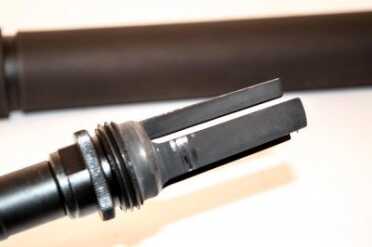
I replaced the Daniel Defense standard flash suppressor with a SilencerCo Trifecta flash hider for ease of mounting the Specwar 7.62 suppressor. As you can see, shooting 300 Blackout suppressed is a dirty business.
Shooting performance and Accuracy
The first thing I did with this rifle, as it offers subsonic ammo options, is mount a suppressor. I replaced the Daniel Defense flash suppressor with a SilencerCo Specwar Trifecta flash hider. This allowed me to easily mount and dismount a SilencerCo Specwar 7.62 suppressor. As the Specwar is rated for full power 7.62, there is no need to take it off when shooting supersonic 300 Blackout loads, but I have the option if I want to lose the weight and length of the silencer. I did shoot groups with and without the suppressor mounted to make sure that the suppressor did not result in any loss of accuracy. It didn’t. If anything, groups tightened up a little bit when using the Specwar.
For accuracy testing, I went nuts and loaded almost two dozen variations of projectile weights, powders and primers. I also used some factory ammo including Hornady 110 grain V-MAX and Gorilla Ammunition 208 grain subsonic loads. Later in this series, I’ll dive into more factory loads and details on the hand loads, but for now, know that the hand loads included 110-grain target and hunting projectiles, 125- and 135-grain Sierra MatchKings, 150 grain full metal jacket bullets, 168 grain Sierra MatchKings, 220 grain MatchKings and 245-grain lead bullets. The range provides just a hint of the versatility of the 300 Blackout caliber. You can find ammo that launches a 110-grain projectile near 2,500 feet per second, a 245-grain projectile at 1,000 feet per second and everything in between.
After a pile of shooting, I’m feeling like this is a “about one minute of angle” rifle. Try as I might, with a dozen different, carefully constructed hand loads, I only got one load to group less than an inch and that was a 125-grain Sierra MatchKing using H110 powder. Nowhere could I find any claims that it should be able to do sub minute of angle, it’s just a fun goal to chase at the range with a new rifle. I’m wishing I had a similar Daniel Defense model in 5.56mm on hand at the moment to shoot side by side. I’d like to see if caliber matters with this particular rifle when it comes to repeatable accuracy.
What I did find was that I could get a variety of loads to group in the .91 to 1.5 minute of angle range at 100 yards. Earlier, I mentioned that this rifle has a mil-spec trigger, so I’m confident groups could be tightened up a bit with an upgraded trigger.
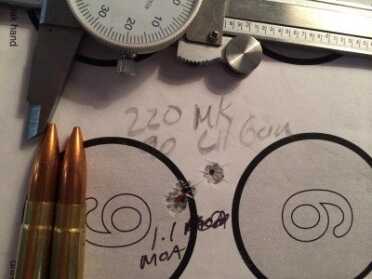
A handload using 220-grain Sierra MatchKing bullets performed exceptionally well. That’s three holes.
I’m doing an article on loads for the 300 AAC Blackout as part of this series, so I’ll keep experimenting with various factory and hand loads to see what type of accuracy performance I can extract out of this gun. One thing I’ve already noticed is that Sierra names some of their projectiles MatchKings for a reason. This rifle really liked MatchKing bullets in a wide variety of projectile weights. In fact, one of the best groups was a subsonic load with the Sierra 220-grain bullets that grouped into 1.1 inches at 100 yards.
One thing I did note was the ejection pattern. If you choose to reload 300 Blackout, you need to save your valuable brass cartridge cases. This rifle ejected cases at a four o’clock angle about 20 feet behind the shooter. Supersonic loads I tested from 110 grains to 168 grains at standard velocity for each were ejected almost identically. I could put a hula hoop on the ground and almost all of them would land in that circle. Subsonic load cases would rumble ad tumble outside in a three o’clock direction for a couple of feet. At least it’s easy to find and collect your brass.
Closing thoughts
I like this rifle. It’s built like a tank, and you can see and feel the attention to detail. The parts fit snugly, and there is no shake or rattle between upper and lower receivers. I particularly like the DDM4 rail system. The length is great for customization, but the feel is also excellent. It’s designed to be narrow side-to-side and taller vertically, so it’s a comfortable grip for of a variety of hand sizes. I added Blackhawk rail covers in all places where my support hand might rest, and those added no bulk.
I’m looking forward to continuing a deep dive with this rifle and the 300 Blackout platform. In upcoming articles, we’ll be looking in detail at ammo, optics solutions, silencers and some of the gotchas to consider with 300 Blackout rifles.
[one_half]
[/one_half]
[one_half_last]
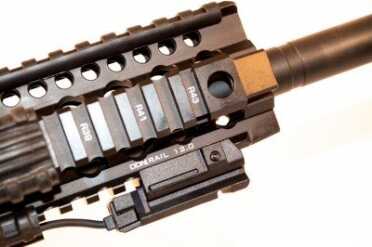
The DDM4 rail, shown here with a LaserMax UNI-MAX ES on the bottom rail with remote activation pad on the right side rail.
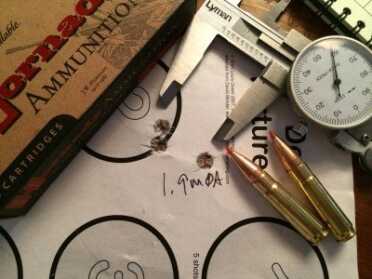
The Hornady 110 grain V-MAX factory ammo performed OK with this rifle with 1.9 minute of angle groups.
[/one_half_last]

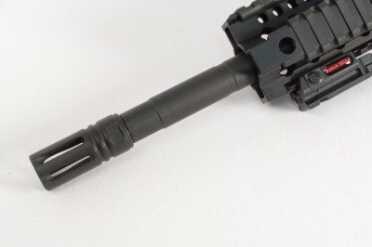
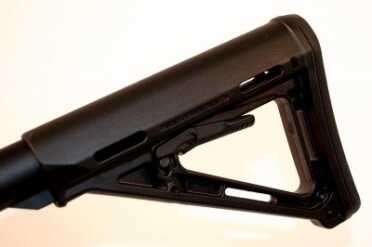
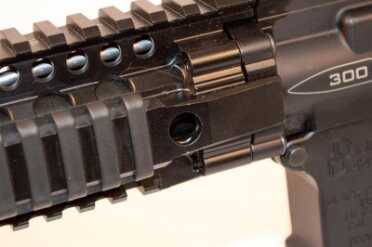
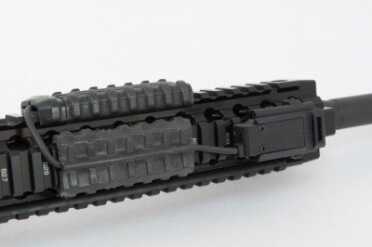
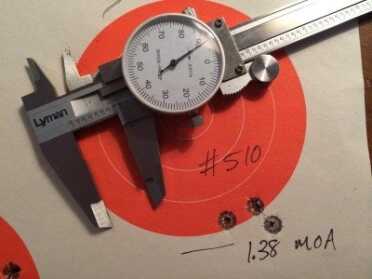
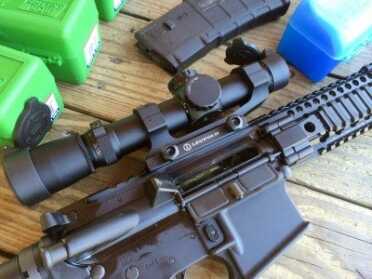
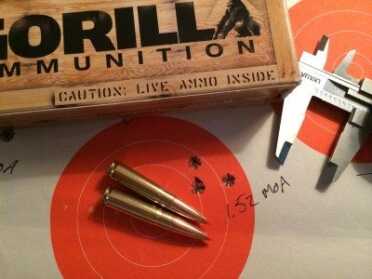
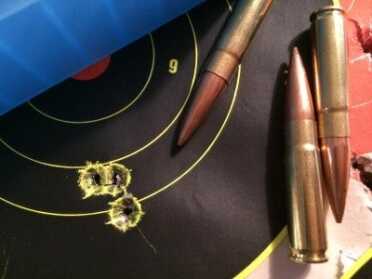
I love my dd rifle with silencerco can in 300 blk. It shoots the gorilla 208 and 220 subsonic better than any other factory subsonic I’ve tried. Matched perfectly. Most fun you can have out of an AR.
I’ve used a Silencerco / SWR Octane 45 with this (subsonic only) and the SilencerCo / SWR Specwar 7.62 (super and subsonic) and the Specwar now lives on this rifle permanently. I’ve shot the Gorilla 208 grain A-MAX and it works like a champ in this carbine length gas system rifle.
I have 2 AR’s I have a Barnes Precision in 300 BLKout and a DPMS in 300 and a 223 barrel.
I really like shooting the 300 as I make my own casings and the cost is not that bad. If you look
the 223/5.56 is getting more expensive. The BLKout is good to 300 yards and that fine for what nearly
everyone needs. Just because a rifle is good to 1000 yards how many people shoot that far. I have a good 308
bolt gun that works just fine for long range.
The 6.8 is nice and you can make cases from 10mm’s brass but look how much that costs!
When the crap hits the fan, I like a 30 cal bullet.
Great write-up! Did you mention the length of the gas system? This is often a hot potato in the 300 BLK forums. I struggled with a carbine-length gas system and cycling subs. The secret sauce turns out to be combinations of the following parameters:
1) a 30 cal. Silencer (my Osprey 45 “do-fer” can didn’t quite cut it for backpressure and carbine length gas),
2) a pistol length gas system (but an adjustable gas block is nice to tune down the supers).
3) and most importantly …….. the holy-grail of 300 BLK powder – A1680, if you can find it.
With the arrival of a long awaited Specwar762, gone is the risk of touching off a supersonic round through the Osprey (only to collect the pieces in a bag downrange). Having never found (or wanted to shell out for) factory 300 BLK ammo, I’ve put 2000 rounds of handloads through my little project (built from an economical M&P 300 Whisper). It’s strikingly close to the rifle configuration you reviewed. Being able to run through 3-gun stages with it on Saturday, then later slip on a can and silently plink or deal with varmints on the homestead (to the delight of my pets and neighbors ears) makes the 300 BLK my favorite rifle platform thus far.
And here you hit the nail on the head!
“3) and most importantly …….. the holy-grail of 300 BLK powder – A1680, if you can find it.”
This particular rifle uses a carbine length gas system, but even still I had good success depending on the projectile type. I was using a Specwar 762 silencer and Pmags, and as long as I stuck to 220 grain Sierra MatchKings for projectiles, cycling was fine. I could not get any of the 245 lead bullets to cycle, but then again, I was not able to obtain any A1680.
Until Daniel Defense makes a piston rifle, I’m not interested.
stfu
yeah stfu
Finally, a review of a product from a manufacturer that I would actually consider owning. Thank you. I have not shot one of these in blackout, but I do own one that was purchased a couple years ago. Outstanding rifle and quality. There is no rattle, no cheapness to it. I would highly recommend the Geissele trigger. I’ve got an SSA in mine and you’ll enjoy it. Also, consider a Battlecomp in place of the flash hider. With those two you’ll get your sub MOA and also greatly improve the accuracy of your rapid fire (at least in 5.56).
Ridiculous…if I expend the cost of a good used car, why am I expected to turn around and buy another trigger to replace the defective one that comes on the gun. With the low cost of modern EDM manufacturing techniques there is absolutely no excuse (short of greed) not to include a first rate fire control mechanism. Virtually every manufacturer does this and Timney, Canjar, and the other aftermarket manufacturers just love it. You can brag it up all you want, but until it comes ready to run it’s just another also-ran in the marketplace.